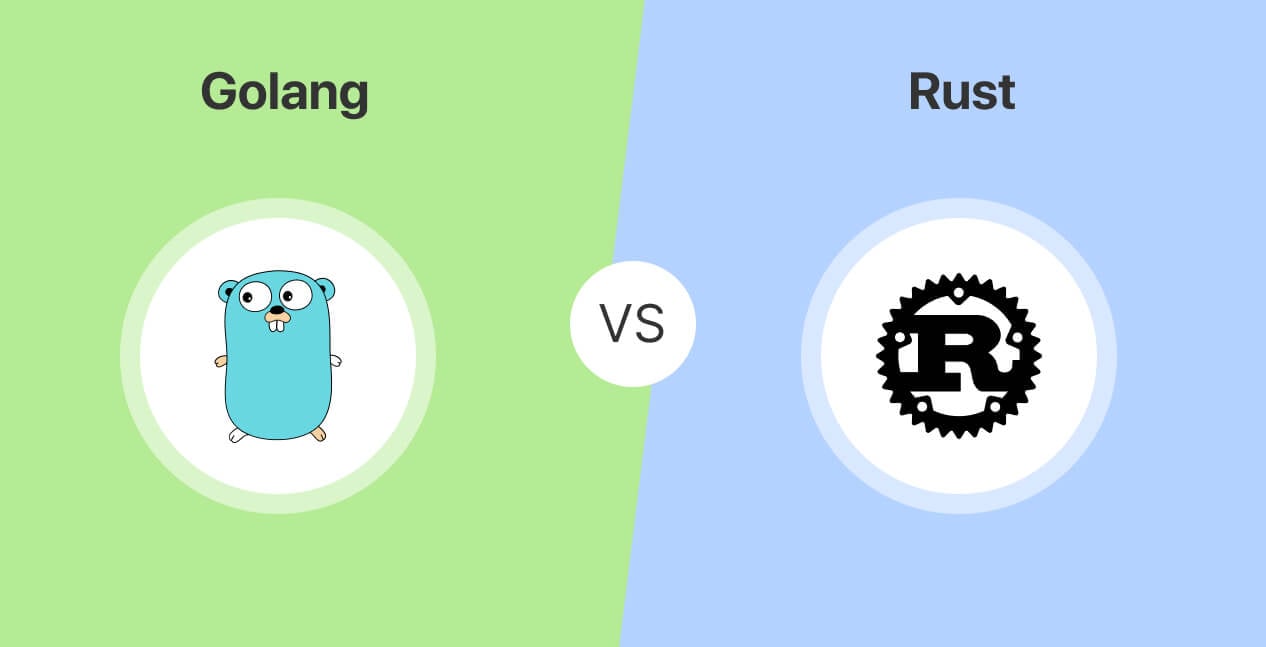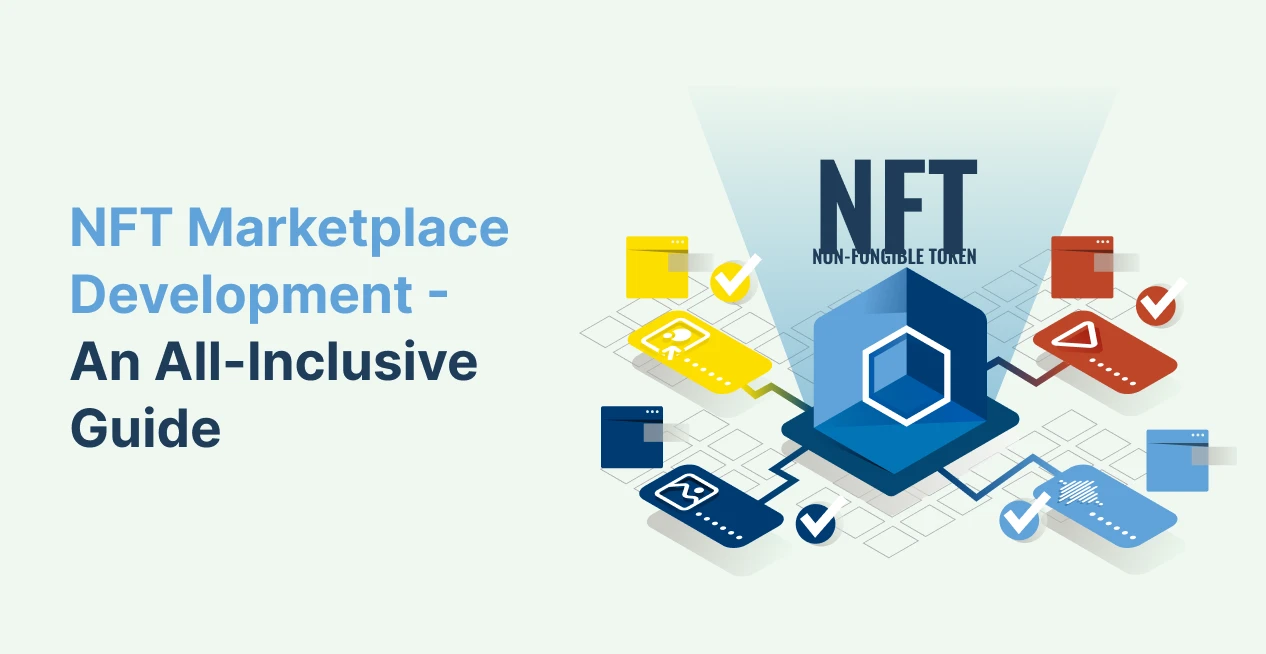-
Introduction - Go vs Rust
-
Go vs Rust: Head-to-Head Comparison
-
What is Go (Golang)
- Golang Features
- Golang Advantages
- Golang Disadvantages
- Golang Use Cases
-
Companies that use Go
-
What is Rust?
- Rust Features
- Rust Advantages
- Rust Disadvantages
- Rust Use Cases
-
Companies that use Rust
-
Rust vs Go: Key Differences
-
Go vs Rust: Similarities
- Go vs Rust: When to use them
-
Golang vs Rust: Which is Better and Why?
-
Rust vs Go: Final Takeaway
- FAQs: Golang vs Rust
Introduction – Go vs Rust
In this comparison between Go vs Rust, despite being designed to serve different purposes, both Rust and Go have many things in common. While Go and Rust both share a similar syntax and attempt to address C++’s drawbacks, they were both developed with distinct design objectives.
Go seeks to make development more appealing and approachable for all developers, regardless of their experience level. It was created to streamline the simultaneous execution of concurrent programs on multi-core computers while still being regarded as a general-purpose programming language.
On the other side, Rust is a systems programming language that was developed to address C++’s memory safety issues and other challenges while maintaining C++’s renowned high performance.
When you hire dedicated developer for any project or business, even they will have different preferences depending on your requirements, and Rust will be a tough competition for Go.
As per a survey, here are the stats on how developers rank Go and Rust along with other peer languages in terms of preferences,
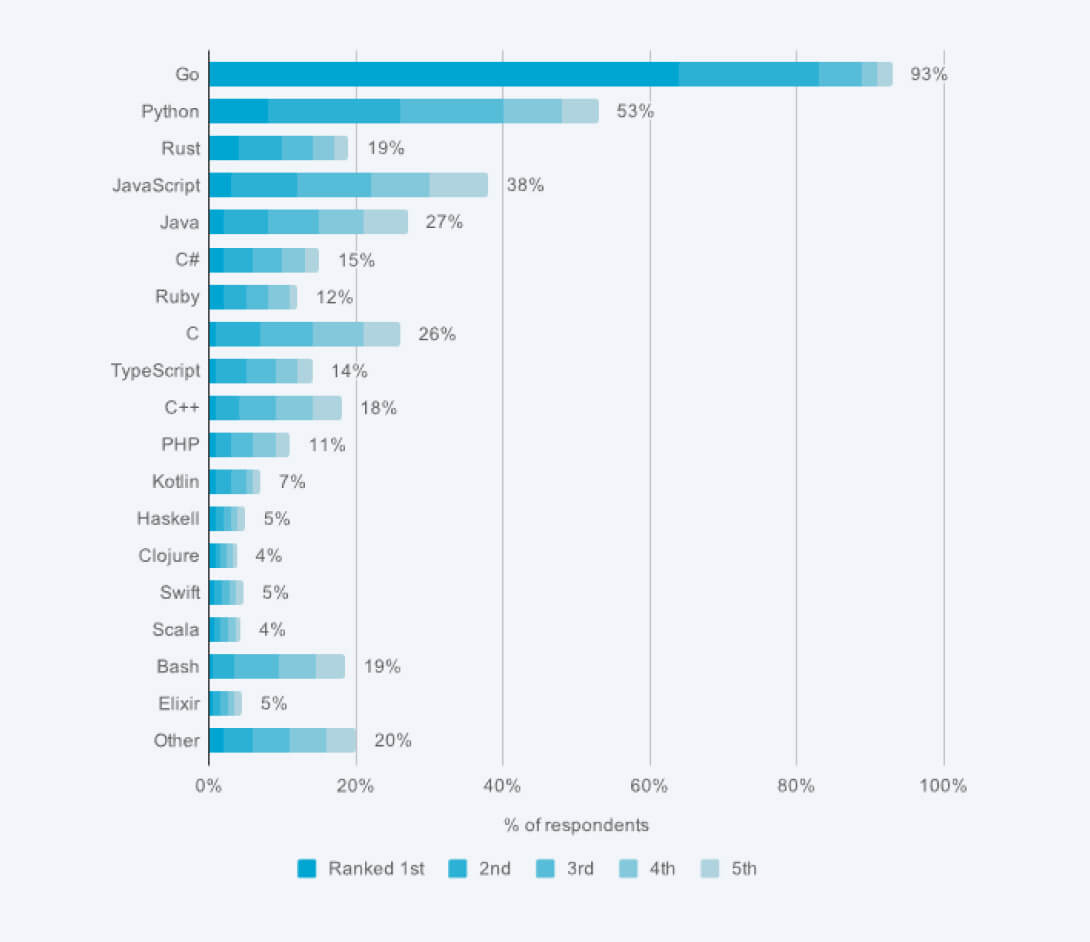
Here, you will learn about both languages briefly, their benefits and disadvantages, and a review of some actual world-use scenarios where you can get help to choose between Go vs Rust, selecting the language that you find better suited to your needs.
Go vs Rust: Head-to-Head Comparison
| Parameter | Golang | Rust |
| Developed by | Mozilla | |
| Launched in | 2009 | 2010 |
| Concurrency | Built-in | No |
| Performance | Comparatively slower | Better |
| Complexity | Simple to understand | Complex language |
| Compilation speed | Faster | Slow |
| Memory management | Automatic memory handling | Not memory safe |
| Multi-threading | Relieved by Goroutines | Better options but additional training |
| Code simplicity | Simpler | Complex |
| Development speed | Faster | Slower |
| Scalability | Highly scalable | Scalable but with complexity |
| Functionality, | High | Low |
| Learning curve | Easy to learn | Complex to learn |
| Community size | Smaller | Bigger |
| Maintenance | Difficult | Easier |
| Development cost | High | High |
| GitHub stars | 101 K | 68.6 K |
What is Go (Golang)
Golang was developed by Google and resembled C in syntax. It added memory safety, garbage collection, and structural typing to address the unsafe operations seen in C++. It is straightforward to use and learn. To maximize parallelism for concurrent programs, it was designed for multi-core computers. Go Routines, an extremely lightweight green thread, are used for concurrent programming.
Go swiftly converts to machine code and has run-time reflection’s strength and convenience as well as garbage collection. It is a quick, statically typed, compiled language that has the feel of an interpreted, dynamically typed language.
Go is a lightweight language that supports a wide range of applications, including microservices, stream processing, CLIs, and many more. Golang offers good support for creating binaries for several systems without the need to install Go on the target. It is ideal for cloud-native applications that are bundled in containers due to its compact and effective binary size.
It is much preferable to use your app container than the JVM languages for microservices because it can be packaged into a small container and deployed in a matter of seconds. Check out my article on installing Go Microservices in Kubernetes for additional details.
Golang Features
Golang is highly feature-rich for the developers to leverage those features and craft the most innovative app. So, to understand the difference between Golang and Rust, you need to have a proper understanding of all the features of Golang. Have a look at these features, in brief,
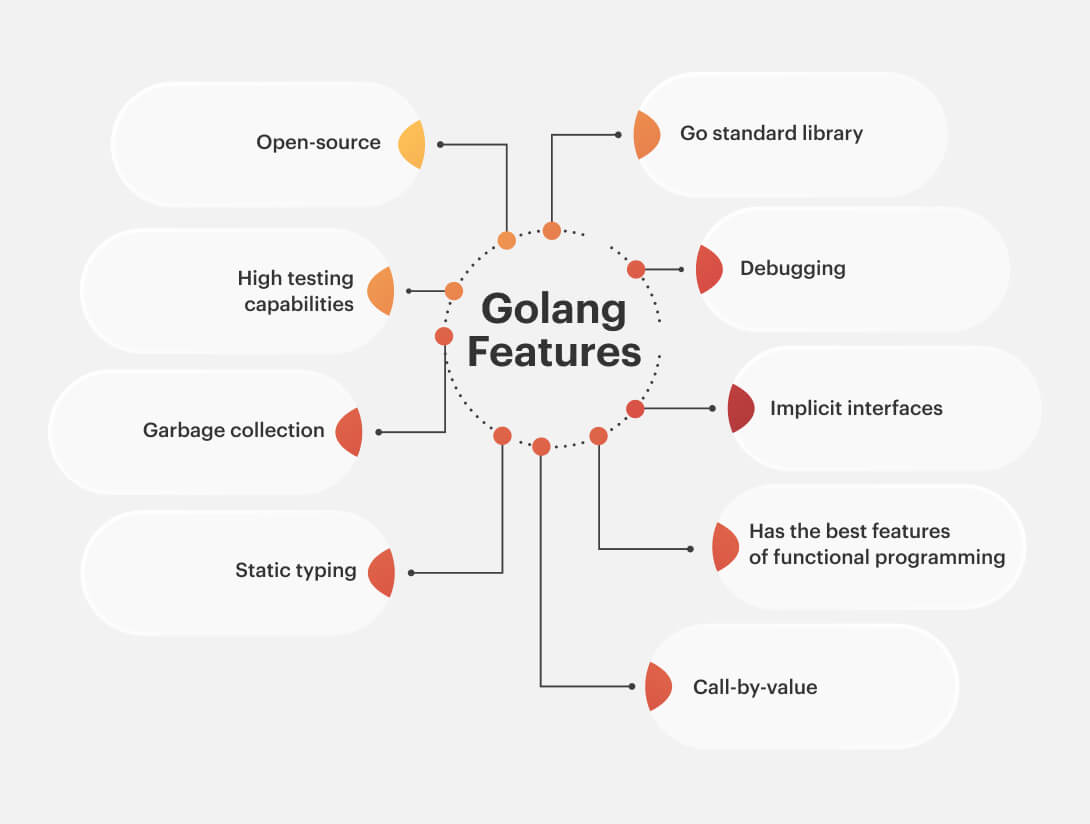
Open-source
Being open-source is the primary attribute of the Golang computer language. Therefore, anyone may download the code and play with it to create better programs and eliminate related errors. This one can be considered the best feature offered by Golang.
High testing capabilities
Along with providing the ability to develop apps, the Go language also provides the ability to build unit tests. Additionally, it offers assistance with benchmark tests, understanding code coverage, and writing sample code for your code documentation. Go provides the developers with complete testing capabilities and enables them to develop code efficiently.
Garbage collection
The garbage collection capabilities of the programming language are excellent. Therefore, pointer clearing and the dangling pointer problem are not concerns for developers. The developers can easily develop complex codes without any worry of clearing up space or freeing the pointers.
Static typing
The method used by the statically typed programming language Go allows for precise code compilation while also taking compatibility level and type conversions into account. This frees programmers from the difficulties presented by dynamically typed languages.
Call-by-value
Yes, Golang uses call-by-value which reduces the job of the garbage collector significantly, thus increasing the speed and supporting memory-efficient applications. When you provide a primitive or struct into a function in Go, Go always creates a duplicate of the variable’s value. In Go, structs and primitives are typically supplied by value, with the asterisk operator providing the option to pass a pointer instead.
Has the best features of functional programming
Thankfully, Go incorporates the finest aspects of functional programming, which is an effective and innovative paradigm. In Go, the functions are values, which means they may be added as values to a map, supplied as arguments into other functions, assigned to variables, and returned from functions. These are called “higher-order functions” and are widely used in Go to construct middleware using the decorator pattern. Also, it is possible to build and automatically call anonymous functions.
In Go, closures are supported by functions defined inside other functions that are functions declared inside of functions that are able to access and modify variables declared in the outer function. Closures are frequently used in idiomatic Go to build up a state that functions later employ in their reasoning, as well as to restrict a function’s scope.
Implicit interfaces
Interface support is available in Go. Interfaces are actually the sole abstract type in Go, it turns out. But in contrast to other languages, interfaces in Go are implemented implicitly rather than explicitly. It is not specified that a concrete type implements an interface. Instead, Go determines that the object implements the interface if the method set for that concrete type includes every method set of the underlying interface.
Go can enforce both type-safety and decoupling thanks to this implicit interface implementation, often known as structural typing while retaining a lot of the freedom seen in dynamic languages. Contrarily, explicit interfaces link the client and implementation together, making it far more challenging to replace a dependence in Java than in Go.
Debugging
One of the most important parts of any language is debugging, While most languages tend to rely on third-party tools, various clever IDEs, etc., Golang has its own Go Playground which is a completely free and online tool that allows you to try and share tiny programs for debugging. This debugging tool by Golang, Go Playground, can be very useful for debugging, making it streamlined and straightforward for the developers.
Go standard library
Golang makes lives easier for programmers by providing a full-fledged standard library. Go, being a young language, caters to all the problems and solutions of the modern world applications in the standard library. In this library, Golang offers complete support for networking, file management, JSON encoding, decoding, etc. With this Go standard library, it becomes extremely easy to set up a server for handling HTTP requests and responses, thus making Go popular for REST-based HTTP web service development.
Golang Advantages
Go language retains simplicity and efficiency due to its amazing language design principles and concise language definition. Here are some more advantages of Golang that make it the first choice of developers as well as clients.
Safe and simple
Golang is a comparatively simpler language for development that offers a simpler way of expressing problems that in turn accelerates the development speed. With a safe environment and simple code review processes, the entire development process is secured and speed is increased.
Easy to adopt
As Go does not require a virtual environment for development, it becomes easy for both junior and senior developers to adopt this language. The easy and simple coding standard of Golang enables the developers to easily adapt it and develop complex applications.
Super fast compiler
The compiler of Golang is super fast as compared to others and thus offers a great deal to the developers. The compiler is so fast that it almost feels like Go is an interpreted language and also it provides awesome developer experience to aid them in development. These aspects increase the overall productivity and make the development process faster.
Kubernetes and cloud-native applications
With the high development speed that it offers, Go can be the perfect language for the development of cloud-native applications. With the smaller application size and lightweight development codes, Go suits best for Kubernetes as well. Golang is also suitable and more preferred as it does not require any warm-up time.
Concurrency with Go Routines
Concurrency, the most well-known feature of Go, enables processing to be carried out concurrently across all of the server’s or machine’s cores. When time performance is crucial and independent processes don’t need to run sequentially, concurrency makes the most sense. It frequently happens with I/O requirements that reading or writing to disc or the network is much, much slower than all but the most complex in-memory processes.
The concurrent execution of a function is enabled by using the ‘go’ keyword before its invocation. Concurrency in Go is a complex and rather difficult feature, but when it makes sense, it offers a strong method to ensure that your program runs as efficiently as possible.
Dynamic language feels
Golang is a static language, but it gives programmers the impression that it is dynamic. The compiler can find many hidden issues, notably syntax faults because it is a static language. Additionally, there are many packages available for developers to utilize, and importing them during development is fairly straightforward, so we are less concerned about their capabilities and feel like we are working with them.
Paradigms
Developers like the fact that the language comes with a built-in testing tool and the fact that it offers the most user-friendly API. This tool’s efficiency makes it easy to profile and test executable programs. Additionally, sophisticated features include running parallel tests, marking tests, and so on. No extra dependence is necessary. Should you own a file named item. Go, create a new file named thing to test, and write your tests inside. Run “go test” now. They can standardize our code, which will make evaluating the function much simpler.
Static code analysis
The study of static code is the only basis for the programming language. Godoc for documentation, gleam for displaying code style, gofmt for formatting code, etc. are a few examples. To make the tool easily adaptable to any coding environment, the Golang developers first presented it as standalone programs for the command line. The language performs a fantastic job at scrutinizing static code and enhancing its reliability.
Golang Disadvantages
Go is far from being a flawless programming language despite its rising popularity. There are undoubtedly many things it might do better. When discussing Golang, I think it’s crucial to keep these things in mind.
Pretty young language
Go is a comparatively young language and newly designed by Google. Even though Go was introduced more than ten years ago, it is still a relatively new language with few libraries and resources, which is the first and most evident drawback. Other languages, like Java, provide a sizable number of pre-existing libraries and built-in functions. Since Go is a “new” language, sometimes developers will have to create their own libraries, and there isn’t a lot of knowledge, support, literature, or online training available for it.
No exceptions
Although exceptions cannot be created directly in Golang, the “panic()” and “recover()” methods can be used to implement the same behavior. This might be a drawback, especially if your programming is based on this organizational style. However, we can still see a slight drawback because you can employ all the behaviors you require. In Python, for instance, exceptions are considered “first-class citizens,” but in Go, you may copy the behavior if you like. Let’s not, however, jump the gun. Soon, we shall compare these two programming languages.
Error handling
Go handles errors somewhat differently than other programming languages. Go resolves errors, to put it simply, by returning a value of type error as a function’s final return value. Nil is returned for the error parameter when a function runs as intended; otherwise, the error value is returned. The caller function then verifies the error return value and either deal with the error directly or throws its own error.
Go functions in this fashion because it pushes programmers to consider exceptions and appropriately handle them. The code is indented in ways that can make it difficult to follow and at least one new code route is added by the try-catch exceptions.
Too simple
Go is straightforward yet annoying. No extensive keyword knowledge is required of developers. The language can be picked up quickly and easily. However, there are situations when programmers are forced to create workarounds since they are missing some functionalities that they have in Python, Java, and C/C++. which, in essence, leads to writing more code. As a result, simplicity often leads to complexity.
No memory management
The absence of manual memory management might result in expensive garbage collection, problems like pauses, and eventually system programming breakdown or lagging. Memory management acts as a backbone of any programming language or framework and in this aspect, Go has a huge drawback. With a lack of memory management, the development of complex applications can be quite dicey.
Golang Use Cases
Golang is a language with a simple syntax that is incredibly scalable and concurrent. This shows that Golang-based systems are extremely scalable and can handle a large number of continuous and simultaneous user requests. Whether it is mobile app development or web ones, Golang can be a fit anywhere. Here are some of the top use cases of Golang.
Go for web browsers
JavaScript is natively supported by web browsers. However, the WebAssembly capability may now run programs written in any programming language on browsers thanks to an intermediary language that is similar to Assembly but is browser-independent. We already know that we can compile C/C++ and Rust to WASM using Emscripten and wasm-pack, respectively.
The standard Go compiler or TinyGo can also be used to compile Golang to WASM. Furthermore, GopherJS allows us to transpile Go to JavaScript while maintaining browser compatibility. The official Go compiler may be used to compile Go to WASM.
Go for automation
Because of the script package, we can utilize Golang for automated tasks. Chainable wrapper functions for the standard library are available in the script package. So you can use this package to create Go shell scripts that are similar to Bash. By reusing your current Go packages, you may create quick shell scripts based on Go. In addition, the Go-based shell script allows you to effectively employ Bash commands, much like Python.
Go for database
By offering top-notch assistance, Golang can assist you in creating and maintaining extremely adaptable databases. Regular SQL and other database packages like Oracle, MongoDB, Postgres, MySQL, BigQuery, SQLite, Redis, and others may be used with ease. Golang offers CockroachDB, GORM, Bleve, InfluxDB, and other libraries and drivers.
Go for cloud-native apps
Golang is a fantastic choice for creating microservices and cloud-native apps. Being a cutting-edge cross-platform programming language, it enables you to swiftly build trustworthy and adaptable cloud apps. To meet the specific needs of your clients, you may create a Go application in Kubernetes utilizing Docker containerization. Additionally, you can obtain auto-scaling and multi-cluster capability because Kubernetes is written in Go.
Go for DevOps
The Go language is becoming more popular in DevOps (Development Operations) and Site Reliability Engineering. Golang excels for CI/CD applications because it allows for build-once and promote-anywhere functionality. It enables you to streamline and optimize CI/CD procedures, and it may also aid in enhancing the scalability and dependability of the websites.
Go for cyber security
Security and privacy continue to attract people. To apply the same in organizations, sectors, and corporations, the cyber market is developing. Golang is a wonderful fit when taking into account the use cases in the cybersecurity industry. Golang is also being used in the industry because of its widespread use in cloud and server settings. Golang web development is the best choice if organizations want the highest level of security.
Go for Fintech
Customers’ steady and ongoing demand for financial data is essential to the fintech industry. There must be constant access to this data. This industry finds that Golang works well for it. Golang’s incredible ability to acquire financial data and manage transactions is one of its strongest use cases.
Companies that use Go
Go is really simple to learn and it is increasingly clear that it is a fantastic programming language. Major corporations are already switching to Go, here are some of the major ones,
- Twitch
- SoundCloud
- BBC
- Medium
- Uber
- Basecamp
- Docker
- Intel
- Heroku
- Apple
- The New York Times
- The Economist
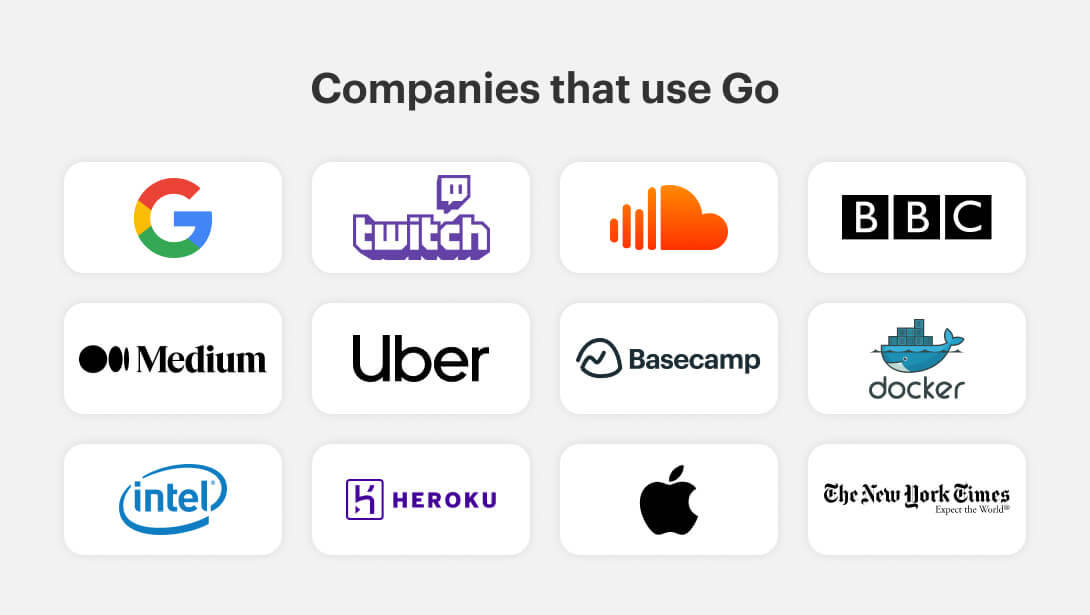

What is Rust?
Rust is a multi-paradigm, general-purpose programming language called Rust was created by Graydon Hoare of the Rust Foundation in 2010. The programming language’s emphasis on memory safety and efficiency, notably its garbage collector system, has earned it a reputation in the industry.
Rust’s syntax is comparable to that of C++, one of the most widely used computer languages in the C family. Rust may therefore be learned quickly and used for a variety of programming and data science tasks by someone with advanced C skills. Programs are written in Rust also use C++ best practices.
Rust addresses issues that C/C++ has long struggled with, such as memory failures and creating concurrent applications. Each reference in Rust also has a lifespan, where you may specify the period of time for which it is valid. This feature sets Rust apart from C and C++ by addressing the issue of references that are no longer valid.
Rust Features
Rust is still one of the most popular choices among developers, despite the existence of several alternative general-purpose programming languages like Python and Java, in part because of its garbage collection mechanism. Here are a few of Rust’s best features,
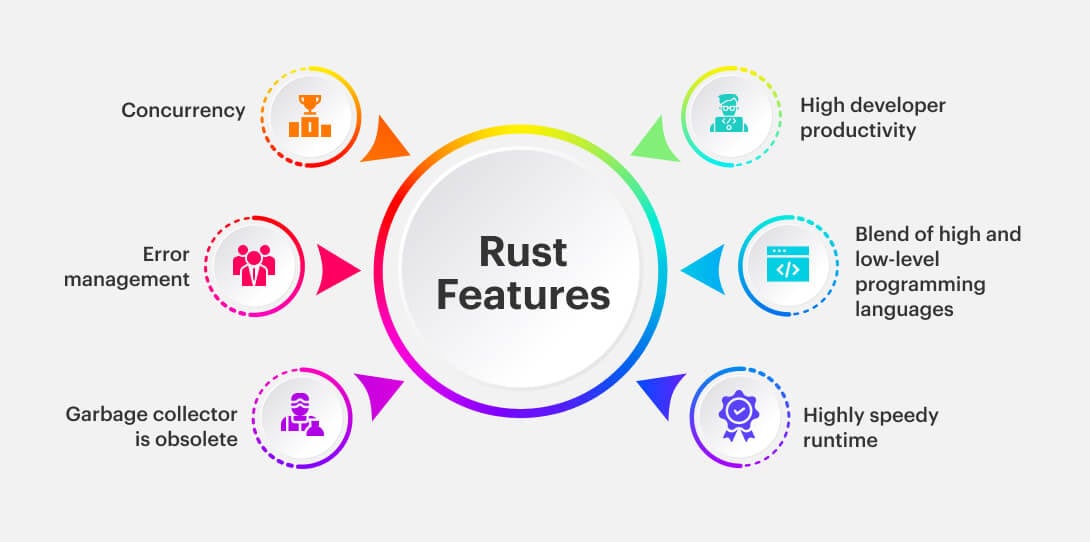
Concurrency
Rust handles concurrency exceptionally well because of its ownership model and type-checking, which ensures that any issues arising from concurrency are caught at compile-time, allowing developers to modify the code as they go rather than maybe having to wait until it has been released to production.
Error management
In contrast to other programming languages, Rust’s security is by far its strongest suit. Error management aids in this to some extent. If an unfixable compilation error occurs, the appropriately titled “panic!” macro is started. This stops the application and displays an error message to prevent any harm from happening.
Garbage collector is obsolete
Without a garbage collector, Rust achieves memory safety. Memory has been a frequent target for hackers across various computer languages. When the memory is full, problems can occur in the system, creating a vulnerability that can be used against the system. Garbage collectors make sure that irrelevant information is removed from memory. However, when the code is executed, this slows down its pace. The “garbage collector” is rendered unnecessary by the Rust compiler. Instead, it looks for potential memory errors during compilation.
Highly speedy runtime
Like C/C++, Rust is a language for system programming and operates at a similar pace when executed. That has something to do with shunning the role of a “trash collector,” on the one hand. Zero cost abstraction, which allows you to program in a language with high degrees of abstraction without experiencing performance drops, also guarantees quick runtime.
Blend of high and low-level programming languages
High-level and low-level programming languages are both parts of Rust. Rust is similar to C/C++ in that it is near to the hardware, ensuring great performance while being just as simple to program.
High developer productivity
One of the top build systems and package managers available is cargo, which is included with Rust and allows developers to increase efficiency. Additionally, it has excellent integration unit and document testing that is integrated right in, which boosts developer efficiency.
Rust Advantages
A statically typed programming language called Rust was developed for speed and security, with a focus on memory management and safe concurrency. Its syntax is comparable to C++’s. Apart from these, some of the awesome advantages of using Rust are,
High-performance
Rust is virtually by definition quicker than the usually interpreted language, like Python, because it uses a compiler. Rust is quicker even when compared to languages like Java that have a JIT compiler created particularly for improving performance.
Safe
Rust takes advantage of a highly stringent compiler that carefully examines each and every variable to guarantee memory safety. The best selling point for Rust is probably type safety. Segmentation faults, sometimes known as segfaults, don’t exist. Segfaults try to read and write to an unauthorized region in memory, which causes applications to crash. However, Rust’s ownership mechanism examines the memory used by your program at build time, thereby avoiding these problems.
Concurrent
In a similar vein to Go, concurrency is a well-known feature of Rust. On the other hand, Rust’s borrow checker sets the language apart from others of its sort. Rust’s unique approach to concurrency is equivalent to multithreading without undefined behavior.
No segfaults
By analyzing the program’s memory management at compile-time, Rust’s ownership system ensures that errors caused by bad memory management cannot occur and that garbage collection is not required. Additionally, you may specifically separate super-optimized implementations from the rest of the code by using the unsafe keyword if you wish to do so in a C-like fashion.
Zero-cost abstractions
Zero-cost abstractions ensure that the abstractions you employ have almost no runtime expense. To put it another way, low-level code and code written with abstractions both execute at the same pace.
Rust Disadvantages
There are drawbacks to every programming language, and Rust is not without its drawbacks. The following are some obvious drawbacks of the Rust programming language:
Relatively new
Due to the fact that Rust is a young technology, certain libraries might not be accessible yet. Nevertheless, the crates.io Rust package library has been expanding quickly since 2016, and the thriving Rust developer community is encouraging for future growth.
Error messages
It may be frustrating to get several error warnings for developers who are not accustomed to working with a language where problems in the code are found at compile time. As a result, writing code takes longer than it would in a more widely used language like Python. The Rust team is working hard to make these error messages as helpful and actionable as they can be, though.
Compile time
Certainly, Rust is a faster programming language than peers. However, compared to other languages, it compiles code a little more slowly. Because its “unit of compilation” is an entire package rather than a single file, it takes longer to build. Rust crates are huge compilation units since they can include numerous modules. Although whole-of-crate optimization has been completed, the whole-of-crate compilation is still necessary, which takes time.
Learning curve
Since Rust has a steep learning curve, it is recommended that anybody interested in using it be familiar with C++ or another object-oriented language. Additionally, compared to other of its peer languages, it is not possible to generate code as quickly.
Single implementation
Single implementation might not seem such an issue, but consider a scenario where Mozilla changes its priorities or Rust becomes insolvent to them, then having only a single implementation exposes a degree of risk.
Rigidness
Although being restrictive is typically regarded as a desirable thing when it comes to programming, Rust may occasionally be overly strict. Being slack is incredibly difficult when you are programming with it. Your software won’t launch unless all the conditions are met.
Rust Use Cases
Rust is helpful when you need to get more out of the resources you have because it is a relatively low-level language. The type system aids in preventing specific sorts of errors during compilation since it is statically typed. Here are some of the top use cases of Rust,
General purpose programming
Since Rust is an open-source system language, it may be used for general programming projects. This includes anything from creating websites to creating important business applications. For a variety of operating systems, you can create third-party programs using Rust.
Backend development for data science applications
Rust may be used to create the backend systems that are the backbone of data science and data analytic tools, even if it is not as well known for data science as Python and R. It is a fantastic tool for low-level code optimization, data security, and data parallelization due to its safety and improved performance characteristics.
Game development
You may develop a whole game using Rust as the primary systems language by using a game engine like Piston or Amethyst Engine. It has quick and effective memory management. Rust is a useful addition to a game developer’s skill set since it shares statistical similarities with C++.
Web development
Programming in Rust is perfect for full-stack web development. Numerous websites can be found online that were created using the Rust programming language and WASM for web-based applications. Rust, according to several programmers, is preferable for the creation of important applications’ backends.
AR/VR application development
If you have access to the appropriate frameworks and libraries, Rust may be utilized to develop VR components. It may be a straightforward VR game, a VR real estate application, or a VR education application. Rust is also useful for creating virtual reality simulation engines.
Companies that use Rust
Due to the popularity of Rust as a programming language, apps are being created using it. It aids in preventing memory problems and poor application performance. The apps created with Rust are listed below.
- Dropbox
- Figma
- Coursera
- Microsoft
- Cloudflare
- Npm
- Amazon
- Mozilla
- Discord
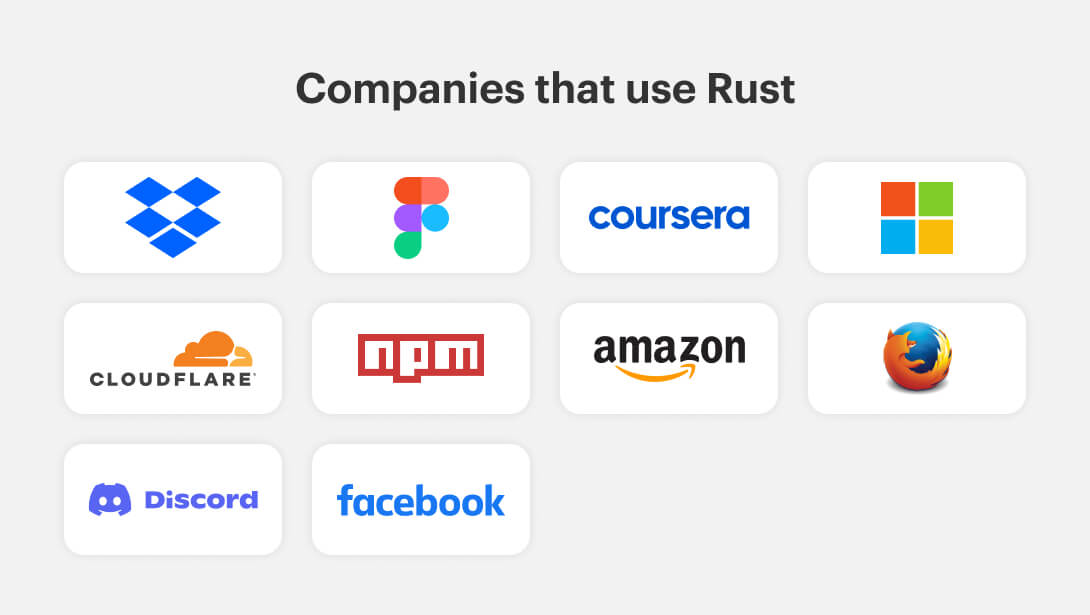
Rust vs Go: Key Differences
Golang and Rust, both languages emerged with the same goal at almost the same time, but they turned out to be quite different in many aspects. Let’s have a look at some of the major differences between Rust vs Go.
- Go is not intended to have any levers or knobs that may be used to increase its performance. Rust is made to provide you with the ability to extract every last bit of performance from the code. Rust’s improved efficiency, nevertheless, comes at the expense of more complexity.
- Because of Go’s rapid iteration capabilities, developers can test ideas fast and focus on writing code that completes the task at hand. Frequently, this suffices, allowing the developer to go on to other projects. On the other side, Rust takes longer to build than Go, which results in slower iteration speeds.
- Go stands out above other languages in that it has maintained a very constant linguistic structure throughout its more than ten-year existence. Therefore, the time spent studying Go retains its value for a very long period. Rust, in contrast, is regarded as a challenging language to learn due to its complexity. Learning Rust typically takes many months before one feels confident using it.
- The developer’s level of control over memory management, how to use the machine’s resources, how to optimize code, and how to create issue solutions is one of Rust’s major advantages. In contrast to Go, which is intended more for quick exploration and turnaround times than for this kind of fine construction, this comes at a significant complexity cost.
Go vs Rust: Similarities
Go and Rust are frequently used interchangeably because of their many similarities. Some of the objectives shared by the two languages are,
- Both Rust and Go are general-purpose programming languages used for the development of web applications, network services, and more
- As both are compiled languages, they directly translate to executable machine code, and the number of dependencies reduces thus making them fast
- As Rust and Go were developed for overcoming the shortcomings of existing programming languages and offer scalability, safety, concurrency, and productivity
- Both Go and Rust include package-management systems that let programmers provide a straightforward list of the packages they want to build upon, and the language tools automatically collect and maintain those packages for them so that programmers can concentrate more on their own work.
Go vs Rust: When to use them
When should you use Golang?
Go functions well for a wide range of use cases. For server-side programs that must manage several separate requests, Go’s concurrency paradigm is an excellent fit. Go offers goroutines precisely for this reason. Additionally, Go already has support for the HTTP web protocol.
Using the built-in HTTP support, you may create a tiny API rapidly and operate it as a microservice. Go therefore meets the demands of API developers and works well with the microservices architecture. Go is an excellent fit, in other words, if you choose the speed of development over performance. Additionally, Go provides higher code readability, a crucial factor for big development teams.
When should you use Rust?
When performance counts, such as when processing a lot of data, Rust is a fantastic choice. Additionally, Rust provides you precise control over how resources are shared across threads and how threads interact with one another. However, because of the additional complexity of memory safety, Rust has a high learning curve and slows down the development pace.
Rust also ensures that you won’t run into memory safety vulnerabilities because the compiler thoroughly examines each and every data reference, thus this isn’t always a negative. This assurance may be useful for intricate systems. When you want precise control over your threads and you worry about performance, use Rust.
Golang vs Rust: Which is Better and Why?
These two languages, Golan vs Rust, are fiercely competitive since they each have their unique advantages and weaknesses. Golang, however, has the advantage based on programmers’ interest and their capacity for speed and flexibility in their approach, and it will keep doing so in the future. However, the decision to use one of these programming languages over another should be made solely in light of business and development goals.
Rust vs Go: Final Takeaway
Although both Rust and Go are well-liked, contemporary, and frequently used languages—neither of which is likely to disappear very soon—they are not rivals. They aim for various use cases. Go vs Rust, Rust is a great option for applications where speed of execution takes precedence over all other factors, but Go’s unrivaled build speed makes it the ideal choice for enterprise-level apps with big development teams.
The decision of the language to choose for your development needs must ultimately be made by you. We hope that you now feel more secure in your choice! In case of any doubts, our expert techies are here for you, share your requirements, queries, or doubts to know more.

FAQs: Golang vs Rust
Can Golang replace Rust?
No, definitely not. Out of the many reasons to justify this answer, the first and foremost will be that both target different niches. While Rust is a lower language and hard to learn, Go is a completely simple, high-level, and easy-to-understand language. Neither Go nor Rust are attempting to “knock the other out of business.” All of these resources are freely offered to the public. Both languages are general-purpose languages that are capable of doing most tasks.
Accordingly, Go aims to be a straightforward yet effective garbage-collected language, whereas Rust aims to replace extremely low-level “systems programming.” It turns out that the Go maintainers largely converted Python specialists instead of the C++ experts they had anticipated. Expertise in C++ will undoubtedly go to Rust, but not likely Python experts. They do, therefore, inhabit various places.
Why is Golang more popular than Rust?
Both Golang and Rust are thought of as rivals with one another because they both emerged around the same time. Golang is developing more quickly than Rust. Golang is highly known and regarded for its adaptability and improved programming experience.
Is Go faster than Rust?
Due to its fine-grained control over how threads operate and how resources are shared across threads, Rust will nearly always defeat Go in run-time benchmarks. Both Rust and Go employ a common formatting tool—rustfmt for Rust and gofmt for Go—that automatically reformats your code in accordance with canonical style.
Rust makes a variety of architectural compromises in order to obtain the fastest execution speed. Go, in comparison, places a higher priority on simplicity and is ready to give up some (run-time) performance in order to achieve it. However, Go’s build speed is unrivalled, which is crucial for huge codebases. Go is slower than Rust.
Why Go and not Rust?
Both Rust and Go are efficient enough and are contemporaries, so it might be wrong to justify why should you choose Go and not Rust. But there are certain features in which Go has an upper hand over Rust. Go is excellent for writing services, and is totally simple when compared to Rust. Rust is not a better Java/C# than Go. Without a question, the clarity that Go can provide to corporate software development is far more useful than keeping trash collection while lowering productivity.
What are the benefits of Rust and Go for web development?
When it comes to web development, both Rust and Go have different features and advantages to offer. So, based on your requirements, type or website or web app, you can choose either Rust or Go for moving ahead with development.


